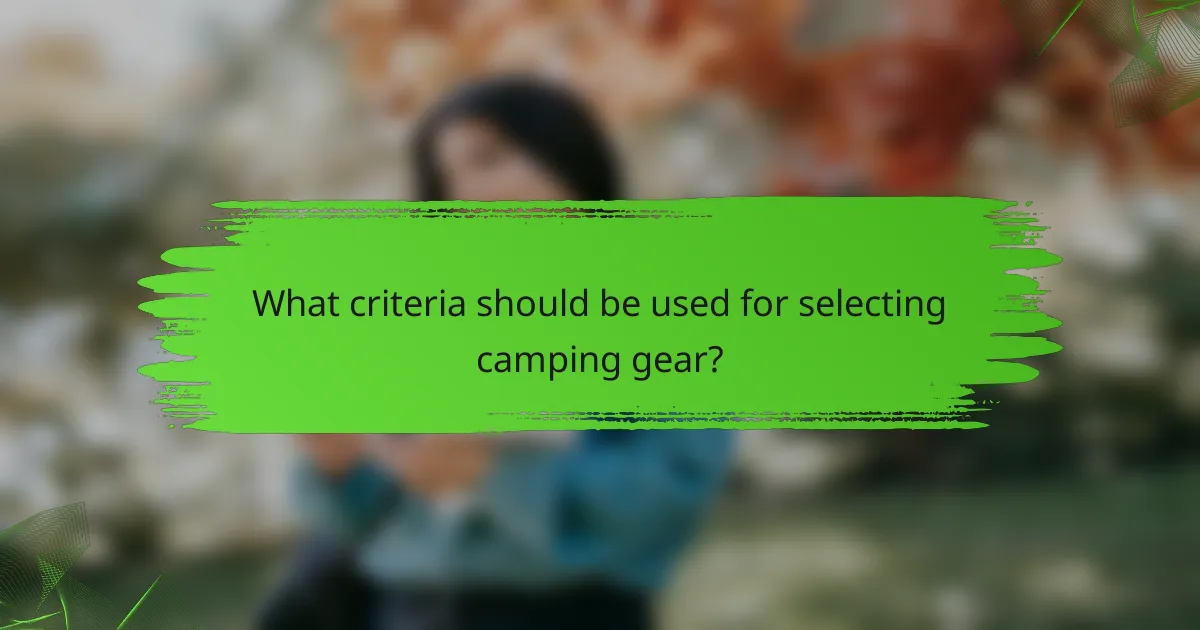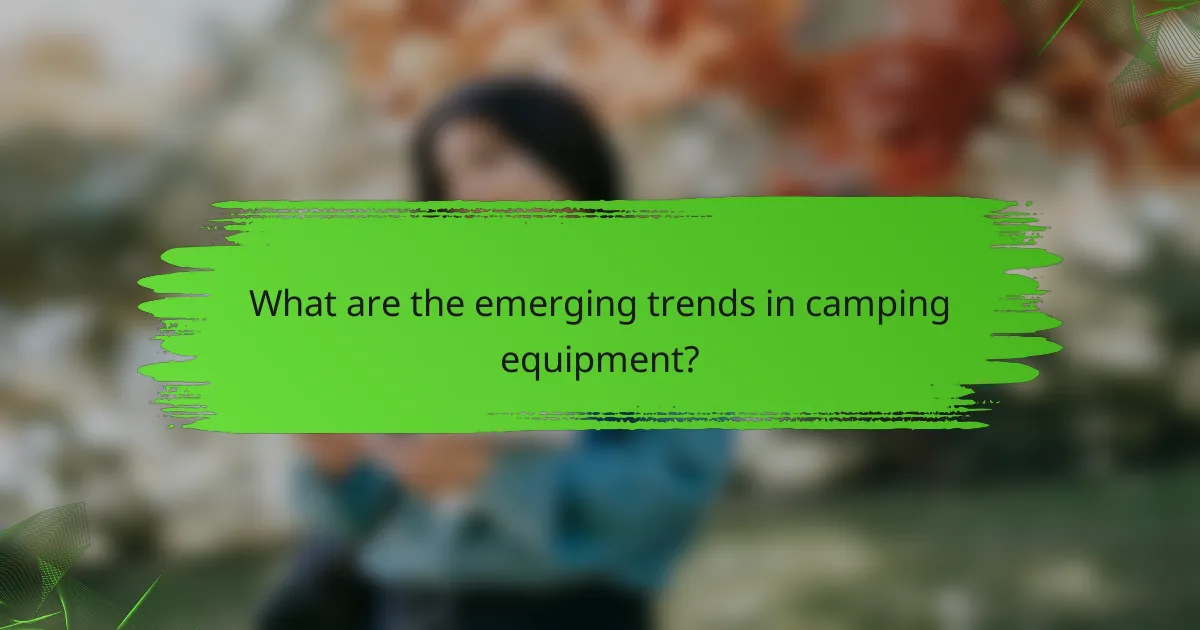When venturing into the great outdoors, choosing the right camping equipment is crucial for a successful experience. Prioritizing lightweight, functional, and versatile gear can enhance your adventure by ensuring portability and adaptability to various conditions. From tents that balance durability and ease of setup to stoves that cater to diverse cooking needs, selecting the right tools will make your camping trip both enjoyable and efficient.

What are the best lightweight camping tents?
The best lightweight camping tents combine portability, durability, and ease of setup, making them ideal for backpackers and campers. When selecting a tent, consider factors such as weight, weather resistance, and space to ensure it meets your outdoor needs.
Big Agnes Copper Spur HV UL
The Big Agnes Copper Spur HV UL is renowned for its exceptional balance of weight and livability. Weighing around 1.5 kg, it offers a spacious interior with vertical walls for increased headroom, making it comfortable for two campers.
This tent features a durable rainfly and a waterproof floor, ensuring protection against the elements. Its easy setup with color-coded webbing and buckles allows for quick assembly, even in adverse weather conditions.
MSR Hubba NX
The MSR Hubba NX is a versatile option designed for solo travelers and couples alike, weighing approximately 1.7 kg. Its unique pole structure provides excellent stability and wind resistance, making it suitable for various terrains.
With a rainfly that can be pitched separately, this tent offers flexibility for different weather conditions. The Hubba NX also includes ample storage pockets and a vestibule for gear, enhancing its functionality for extended trips.
REI Co-op Quarter Dome SL
The REI Co-op Quarter Dome SL is an affordable lightweight tent, weighing around 1.4 kg, perfect for budget-conscious campers. Its design maximizes interior space while maintaining a low weight, making it a popular choice for backpackers.
This tent features a rainfly with a high waterproof rating, ensuring you stay dry during unexpected rain. The quick setup process and compact packed size make it easy to carry on long hikes, providing a practical solution for outdoor adventures.

How does functionality impact camping gear choices?
Functionality significantly influences camping gear choices by determining how well equipment meets specific needs and enhances the overall camping experience. Selecting gear that serves multiple purposes can save space and weight while ensuring you are prepared for various situations.
Multi-functional tools
Multi-functional tools are essential for minimizing weight and maximizing utility in camping gear. Items like a multi-tool can combine several functions—such as a knife, screwdriver, and can opener—into one compact device, reducing the need to carry multiple separate tools.
When choosing multi-functional tools, consider the most common tasks you will encounter during your trip. For example, a tool that includes a fire starter and a whistle can be invaluable for safety and convenience. Aim for tools that balance versatility with durability, ensuring they can withstand outdoor conditions.
Weather resistance features
Weather resistance features are crucial for camping gear, as they protect against rain, wind, and temperature fluctuations. Look for tents with waterproof ratings, sleeping bags with thermal insulation, and clothing made from breathable, water-resistant materials to enhance comfort and safety.
When evaluating weather resistance, consider the climate and conditions you expect to face. For instance, a tent suitable for summer camping may not hold up in winter conditions. Always check product specifications for weather ratings and choose gear designed for the specific environment you will encounter.

What are the top versatile camping stoves?
The top versatile camping stoves are designed to be lightweight, efficient, and adaptable for various cooking needs while camping. These stoves can handle different cooking styles, from boiling water quickly to simmering meals, making them essential for outdoor enthusiasts.
Jetboil MiniMo
The Jetboil MiniMo is a compact and efficient stove known for its fast boiling times and excellent simmer control. Weighing around 400 grams, it is lightweight enough for backpacking while offering a 1-liter cooking capacity, which is suitable for solo or small group meals.
This stove utilizes a unique FluxRing technology that enhances heat transfer, allowing water to boil in just a few minutes. Its integrated pot and burner design minimizes the need for additional cookware, making it a practical choice for campers looking to save space.
When using the MiniMo, ensure you have a compatible fuel canister, and consider the wind conditions, as it performs best in sheltered areas. Avoid over-tightening the connections to prevent damage.
MSR PocketRocket 2
The MSR PocketRocket 2 is a lightweight canister stove that excels in portability and ease of use, weighing approximately 73 grams. It is ideal for minimalist campers who prioritize weight savings without sacrificing performance.
This stove can boil a liter of water in about three and a half minutes, making it efficient for quick meals. Its foldable pot supports provide stability for various pot sizes, and it can be used with a range of cookware, enhancing its versatility.
For optimal performance, use the PocketRocket 2 with MSR fuel canisters and ensure proper ventilation while cooking. Be cautious of the flame, as it can be quite intense; always monitor your cooking to avoid burning food.

What criteria should be used for selecting camping gear?
When selecting camping gear, prioritize weight, durability, and versatility to ensure a successful outdoor experience. These criteria help balance comfort, functionality, and ease of transport, allowing you to enjoy your adventure without unnecessary burdens.
Weight considerations
Weight is a critical factor in camping gear selection, as it directly affects how easily you can carry your equipment. Aim for lightweight options, especially for items like tents, sleeping bags, and cooking gear, which should ideally weigh no more than a few kilograms each.
Consider using materials such as nylon or aluminum, which offer strength without excessive weight. A good rule of thumb is to keep your total pack weight below 20% of your body weight for optimal comfort during hikes.
Durability ratings
Durability ratings indicate how well camping gear can withstand the rigors of outdoor use. Look for products made from high-quality materials with good abrasion resistance, waterproofing, and UV protection. For example, tents should have a minimum waterproof rating of 1,500 mm to ensure protection from rain.
Check for user reviews and manufacturer specifications to gauge durability. Investing in gear with higher durability ratings may cost more upfront but can save money in the long run by reducing the need for replacements.

How does camping gear vary by location?
Camping gear varies significantly by location due to differing environmental conditions, terrain, and climate. Understanding these variations helps campers select the right equipment for safety and comfort.
Desert camping gear
When camping in the desert, gear must address extreme temperatures and arid conditions. Essential items include a high-quality tent that provides UV protection, a sleeping bag rated for both hot and cool nights, and plenty of water storage options.
Consider lightweight and breathable clothing to stay cool during the day and warm at night. A portable shade structure can also be beneficial for daytime comfort. Always pack a first aid kit and navigation tools, as desert areas can be remote.
Mountain camping gear
Mountain camping gear should be tailored to handle variable weather and rugged terrain. A sturdy tent with good insulation and waterproofing is crucial, along with a sleeping bag designed for colder temperatures.
Invest in durable hiking boots with good traction and moisture-wicking clothing to manage sweat and temperature changes. Additionally, bring layers to adapt to fluctuating conditions, and consider gear like trekking poles for stability on uneven ground.

What are the emerging trends in camping equipment?
Emerging trends in camping equipment focus on sustainability, technology integration, and compactness. These innovations enhance the camping experience by making gear more efficient, environmentally friendly, and easier to transport.
Sustainable materials
Camping gear made from sustainable materials is gaining popularity as outdoor enthusiasts become more environmentally conscious. Products made from recycled plastics, organic cotton, and biodegradable materials reduce the ecological footprint of camping activities.
When selecting sustainable camping equipment, look for certifications like Global Organic Textile Standard (GOTS) or bluesign® to ensure that the materials meet specific environmental standards. Brands are increasingly transparent about their sourcing and manufacturing processes, making it easier for consumers to make informed choices.
Smart camping technology
Smart camping technology includes gadgets that enhance safety, convenience, and connectivity while camping. Examples include solar-powered chargers, GPS-enabled devices, and smart tents that monitor weather conditions.
Consider investing in a portable power bank with solar capabilities to keep devices charged during extended trips. Additionally, smart thermometers and weather apps can help campers prepare for changing conditions, ensuring a safer and more enjoyable experience.
Compact designs
Compact designs in camping equipment focus on minimizing weight and bulk without sacrificing functionality. Lightweight tents, collapsible cookware, and multi-functional tools are examples of gear that maximize efficiency.
When choosing compact camping gear, prioritize items that serve multiple purposes, such as a sleeping bag that converts into a blanket or a stove that doubles as a pot. This approach not only saves space but also reduces the overall weight of your pack, making it easier to hike and travel.



